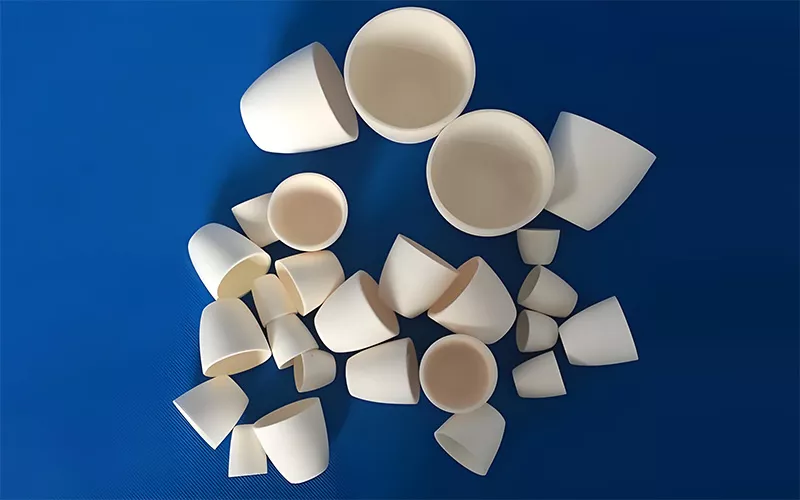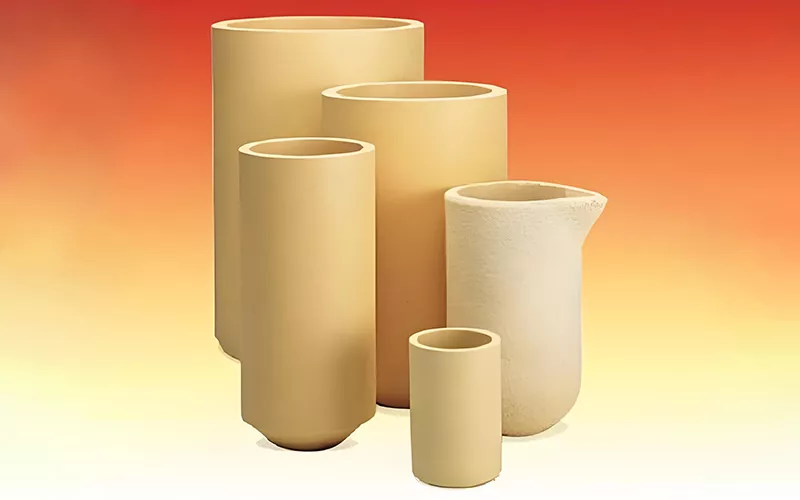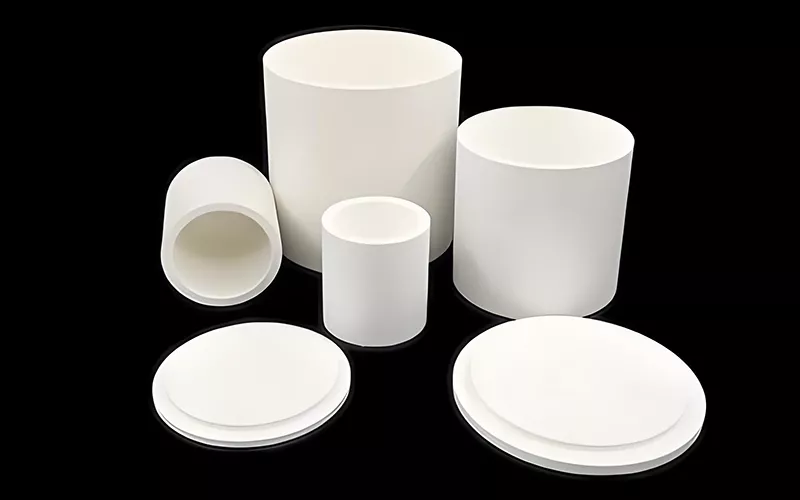Ceramic crucibles are containers with high melting points and high temperature resistance. They combine chemical stability with a low coefficient of thermal expansion, making them essential tools for extremely high-temperature applications in laboratories, metallurgy, semiconductor manufacturing, and other fields.
Ceramic crucibles are primarily made from advanced ceramics such as alumina, boron nitrida, Dan zirkonium oksida. In this article, we’ll explore ceramic crucible material selection, key characteristics, and service life to help you select the most suitable crucible for your high-temperature application.

Apa Bahan dari Wadah Keramik?
Wadah Alumina
Cawan lebur keramik alumina are primarily made of 99.7% pure aluminum oxide. Did you know? During the production process, many manufacturers, such as GORGEOUS, add small amounts of magnesium oxide (MgO) and silicon dioxide (SiO2) to impart superior physical and chemical properties to the crucibles.
Key Features: High-Temperature Resistance - Alumina crucibles can withstand temperatures of approximately 1700°C in a redox atmosphere. While offering superior performance, alumina crucibles are also price-competitive, making them the preferred material for many manufacturers.
Applications: Alumina crucibles are primarily used in laboratory and industrial metallurgy, heating, and chemical reactions.
Advantages: Alumina crucibles are one of the most economical ceramic crucibles on the market. Alumina’s high melting point and low thermal expansion coefficient make them resistant to cracking. They are ideal reaction vessels for weakly alkaline substances.
Limitations: Strongly corrosive substances, such as the strong base sodium hydroxide (NaOH), can severely damage alumina crucibles. For these materials, GORGEOUS recommends using a crucible material with strong corrosion resistance instead of alumina crucible.
Wadah Zirkonia
Zirconia crucibles are primarily made of high-purity zirconium oxide. Their exceptionally high temperature resistance and chemical stability make them ideal for extremely high-temperature melting processes.
Key Features: Zirconia crucibles boast robust high-temperature resistance, capable of withstanding temperatures up to 2000°C, making them ideal for melting precious metals such as platinum (Pt) and palladium (Pd).
Zirconium oxide also possesses excellent chemical resistance, maintaining a stable structure even in harsh environments with strong acids and alkalis, making it an ideal crucible material for processes prone to corrosion.
Applications: Zirconia crucibles are primarily used in precious metal melting and certain processes involving high-melting-point materials.
Wadah Alumina yang Diperkeras dengan Zirkonia (Wadah ZTA)
Zirconia-toughened alumina crucibles (ZTA) are primarily made of 90% alumina and 10% zirconia. This ceramic material combines the advantages of both alumina and zirconia, offering excellent high-temperature resistance and high toughness.
Key Features:
High Toughness - The addition of zirconia significantly improves the crucible’s crack and wear resistance, reducing damage caused by high temperatures and mechanical shock.
High-Temperature Resistance - ZTA crucibles can withstand temperatures up to 1700°C and operate stably in high-temperature environments.
Thermal Shock Resistance - Compared to pure alumina crucibles, ZTA crucibles offer higher thermal shock resistance, are more stable under severe temperature fluctuations, and are less prone to cracking.
Applications: These crucibles are primarily used in processes requiring high mechanical strength and high-temperature stability.
Wadah Boron Nitrida (Wadah PBN)
Boron nitride crucibles are specially designed for use at extremely high temperatures. Their primary component is pyrolytic boron nitride.
Key Features:
High-Temperature Resistance - Boron nitride crucibles offer exceptional high-temperature resistance. In a protective atmosphere, they can reach temperatures of up to 2100°C and remain stable. They will not melt or react chemically with the substrate at extremely high temperatures.
Thermal Conductivity - Boron nitride crucibles have excellent thermal conductivity, allowing them to quickly dissipate heat, effectively preventing localized overheating, thermal stress, and thermal damage.
Low Thermal Expansion Coefficient - Boron nitride has a low thermal expansion coefficient, effectively reducing the risk of crucible cracking in high-temperature processes requiring rapid cooling or heating.
Applications: Boron nitride crucibles are primarily used in high-temperature processes such as semiconductor manufacturing and metal smelting. In the semiconductor industry, they are often used in chemical vapor deposition (CVD), crystal growth, and high-temperature evaporation.
Bahan Keramik Lainnya
Selain bahan keramik umum yang disebutkan di atas, ada juga bahan wadah berkualitas tinggi seperti magnesium oksida dan berilium oksida. Semuanya memiliki kinerja suhu tinggi yang sangat baik dan merupakan bahan wadah wadah penting untuk banyak peleburan logam dan laboratorium.
Bagaimana Memastikan Masa Pakai Crucible?
If you want your crucible to have better performance and service life, you’d better do the following:
Penyimpanan:
Sebaiknya wadah bekas disimpan di lingkungan yang kering dan bersih untuk mencegahnya menyerap kelembapan dan kontaminasi. Sebaiknya hindari menyimpan wadah di dekat bahan kimia atau di area dengan kelembapan tinggi.
Beroperasi:
Anda harus menggunakan peralatan yang tepat untuk mengoperasikan wadah peleburan, hindari kontak langsung dengan tangan Anda, dan periksa apakah ada retakan atau kerusakan setelah digunakan.
Pembersihan:
Anda harus membersihkan wadah peleburan secara menyeluruh setelah setiap kali digunakan. Semua residu harus dibuang dan harus diperhatikan agar wadah peleburan mendingin dengan benar sebelum dibersihkan untuk mencegah guncangan termal dan keretakan.
Tanya Jawab Umum
1. Apa itu crucible?
Crucible adalah wadah yang dirancang untuk digunakan pada suhu yang sangat tinggi, terutama digunakan untuk peleburan logam dan reaksi kimia.
2. Berapakah titik leleh wadah keramik?
Titik leleh wadah keramik terutama bergantung pada bahan yang digunakan. Misalnya, wadah alumina dapat menahan suhu antara 1650°C dan 1700°C, sedangkan wadah zirkonia dapat menahan suhu hingga 2000°C.
3. Apa kegunaan wadah keramik dalam kimia?
Crucible keramik sering digunakan untuk peleburan logam suhu tinggi, sebagai wadah reaksi kimia, wadah pemrosesan material, dan lain-lain.
4. Apa fungsi wadah keramik?
Wadah keramik terutama digunakan untuk aplikasi pemanasan suhu tinggi, peleburan atau pemurnian material, dan lain-lain. Wadah ini juga dapat berfungsi sebagai wadah untuk beberapa reaksi kimia.
5. Apa saja sifat material dari wadah keramik?
Bahan keramik memiliki karakteristik titik leleh tinggi, koefisien ekspansi termal rendah, stabilitas termal yang baik, dan ketahanan terhadap korosi kimia.
6. Bisakah wadah keramik digunakan untuk melelehkan zat alkali kuat?
Hal ini terutama bergantung pada bahan wadah peleburan. Secara umum, kami tidak menyarankan Anda menggunakan wadah peleburan alumina untuk melelehkan zat alkali kuat seperti natrium hidroksida (NaOH) dan natrium peroksida (Na2O3), karena zat-zat ini dapat merusak wadah peleburan.
7. Apa perbedaan antara wadah porselin dan wadah keramik?
Wadah porselen biasanya mengacu pada wadah yang terbuat dari bahan porselen. Wadah keramik memiliki kinerja yang lebih kuat daripada wadah porselen tradisional, dapat menahan suhu yang lebih tinggi, dan memiliki sifat mekanis yang lebih kuat.
8. Bagaimana cara memanaskan wadah keramik?
Saat memanaskan wadah keramik, Anda harus memilih metode pemanasan yang sesuai menurut karakteristik bahan wadah. Perlu diperhatikan bahwa pendinginan atau pemanasan mendadak harus dihindari selama pemanasan, yang dapat menyebabkan wadah retak.
9. Apa saja metode pemeliharaan untuk wadah keramik?
Setelah menggunakan wadah peleburan, Anda harus membersihkannya secara menyeluruh untuk menghilangkan residu, dan menggunakan larutan pembersih yang tepat untuk membersihkannya, dan terakhir membilasnya dengan air bersih dan mengeringkannya untuk digunakan nanti.
Kesimpulan
Ceramic crucibles are indispensable tools in modern chemistry and metallurgy. Capable of operating in extreme temperatures and harsh chemical environments, they play a key role in a wide range of scientific and industrial applications. GORGEOUS, a leading international supplier of advanced ceramics, offers custom-made ceramic crucibles in a variety of materials. Thank you for reading this article, and we hope you find it helpful.